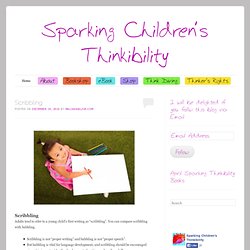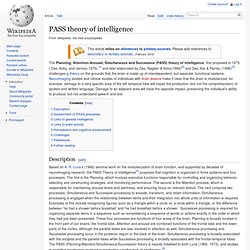

Do! A Minimalist Handmade Pictogram Book in the Style of Indian Tribal Art. By Maria Popova Beautiful visual storytelling from the Warli tradition, hand-crafted by local artisans.

From Indian author Gita Wolf and the fine folks at Tara Books, makers of beautiful handcrafted books, comes Do! — a lovely set of action pictures rendered in the elegant minimalism of Warli tribal art. Patent US3879861 - CHARACTER ANALYSIS EDUCATIONAL GAME OBJECTS OF THE - Google Patents. United States Patent [1 1 Grantham 1 CHARACTER ANALYSIS EDUCATIONAL GAME [76] Inventor: Frederick W.

Grantham, 600 S. Lairport St., Santa Monica, Calif. 90245 22 Filed: Mar. 1, 1973 21 Appl. No.: 336,979 1 Apr. 29, 1975 995,270 8/1951 France 273/157 R Primary Examiner-Harland S. Rhoda Kellogg. Form-similarity between Phosphenes of Adults and pre-School Children's Scribblings. On Neuropsychology and Shamanism in Rock Art. Interglacial lasted about 25,000 years (Turner 1975).

To- crease in Alnus, Betula, and Pinus pollen (Turner 1970). James (pp. 8-9) interprets the increase in Betula and Pinus as indicating that deforestation did not take place. is a relative-frequency pollen diagram. Little. Rich and Clarke 1967). They would tend to bolster the deforestation hypothesis. Betula preferentially colonises open ground. Walker I 984:I 5 8) and ecologically meaningless.
Too sceptical. In the temperate deciduous forests of southern England. The cause of this is a separate issue. Australian Rock Art Research Association, P. 0.Box 216, Caulfield South, Victoria 3162, Australia. 21 IV 89 persuasive. IJHC (The International Journal of Healing and Caring) - From Prehistoric Shamanism to Early Civilizations: Eye Floater Structures in Ancient Egypt* By Floco Tausin Download PDF.

Karrinyarra Artists. Phosphene Motifs Background: Llwyd 2012 For many years we explored the rock art of the western desert particularly about the water rock holes and often found extroidinary ancient petroglyphs and ocher paintings There was a deep personal collision of cultures in ourselves when we explored the petroglyphs of the Boyne valley north of Dublin, EIRE, where, we came across the same petroglyph motifs After 30 years experiance of painting and drawing with children, I confirmed that these Phosphene Motifs hold the patterns as universal visual patterns Illustration © Kellogg, R, Knoll, M., Kugler, J. (1965).

Visual arts carry iconic imagery we call phosphene motifs. They appear to mirror the nerve receptors of the eye brain connections and have been named “archetypes of the collective neural system “ With these Karrinyarra paintings we can align the universal phosphene patterns with a continuum of myth and meaning that maintains relationships with Land and Family. Artful Scribbles: The Significance of Children's Drawings - Howard Gardner.
Cellreviews_v2_n2.pdf. Further Experiments with the Scribbling Game - Projection Method - Journal of Projective Techniques - Volume 15, Issue 3. Sparking Children's Thinkibility. Scribbling Adults tend to refer to a young child’s first writing as “scribbling”.

You can compare scribbling with babbling. Scribbling is not “proper writing” and babbling is not “proper speech”. But babbling is vital for language development, and scribbling should be encouraged since it is important for the development of writing and reading skills. Large movements For a young child drawing and writing is the same thing. A child has to figure out how to use a crayon, with practice your child gain control over the muscles in his hands. Applied Psycholinguistics - Abstract - Writing starts with own name writing: From scribbling to conventional spelling in Israeli and Dutch children. Representational activity during mother-child interaction: The scribbling stage of drawing - Yamagata - 2011 - British Journal of Developmental Psychology.
The developmental characteristics of four- and five-year-old pre-schoolers’ drawing: An analysis of scribbles, placement patterns, emergent writing, and name writing in archived spontaneous drawing samples. Review of Research in Visual Arts Education, Vol. 7, No. 2(14) (Fall 1981), pp. 36-48. Bing. Valeriaanjos. PASS theory of intelligence. Description[edit] Based on A.

R. Luria’s (1966) seminal work on the modularization of brain function, and supported by decades of neuroimaging research, the PASS Theory of Intelligence[2] proposes that cognition is organized in three systems and four processes. The first is the Planning, which involves executive functions responsible for controlling and organizing behavior, selecting and constructing strategies, and monitoring performance. The second is the Attention process, which is responsible for maintaining arousal levels and alertness, and ensuring focus on relevant stimuli. Assessment of PASS processes[edit] The PASS theory provides the theoretical framework for a measurement instrument called the Das-Naglieri Cognitive Assessment System (CAS), published in 1997.[5] This test is designed to provide a nuanced assessment of the individual’s intellectual functioning, providing information about cognitive strengths and weaknesses in each of the four processes.
Challenges[edit] Das, J. CAS - Das-Naglieri Cognitive Assessment System. Planning, Attention, Simultaneous, and Successive (PASS) Cognitive Processes as a Model for Intelligence. Validity of the Comprehensive Test of Nonverbal Intelligence (CTONI)